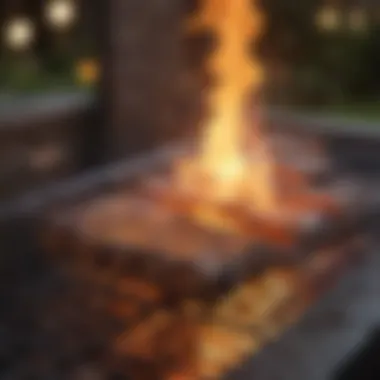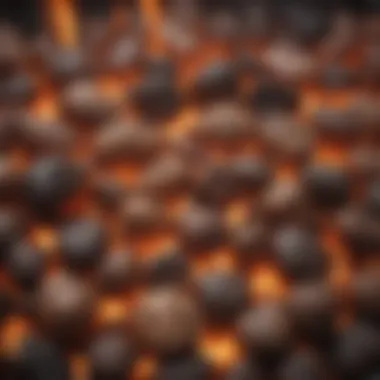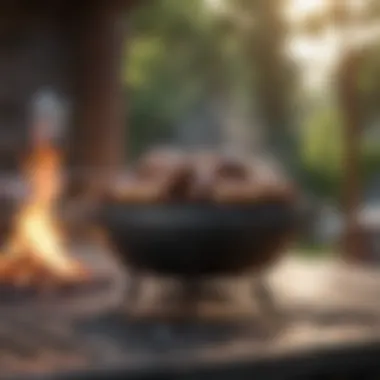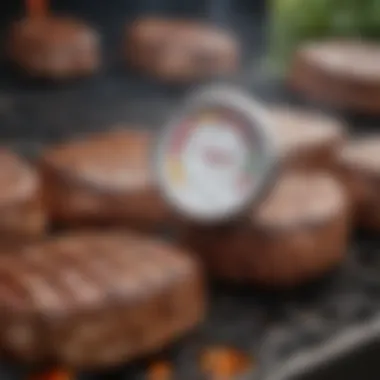Mastering the Art and Science of Barbecue Lighting


Intro
Lighting a barbecue is both an art and a science. It requires a precise understanding of fuel types, techniques, and safety measures. For those keen on mastering outdoor cooking, this guide will illuminate the steps necessary to ignite the perfect barbecue.
First, let’s acknowledge the key components involved in the process. Planning is crucial. Choosing the right time, gathering the materials, and understanding the barbecue setup can make or break your experience. Whether you are using charcoal, propane, or natural wood, each fuel type has unique characteristics that influence how you light your grill and the quality of the food. Understanding these aspects empowers cooks to achieve optimal cooking temperatures efficiently.
In addition, safety should always be a priority. Knowing how to handle fire and fuel, along with proper equipment usage, is essential. This article will explore various methods for lighting barbecues, ensuring not just a delightful cookout but also a safe environment.
Fuel Types and Preparations
When it comes to fuel, choices abound. Each option presents distinct flavors and cooking characteristics, helping chefs tailor their barbecuing approach.
- Charcoal: Provides a strong flavor and high heat. It requires lighter fluid or chimney starters for ignition.
- Propane: Convenient and easy to control. A propane grill is quicker to ignite and can reach desired temperatures faster.
- Wood: Adds unique flavors. It requires more attention to maintain fire levels.
- Lump Charcoal: Burns hotter and faster, ideal for quick grilling.
- Briquettes: Offer a steady heat for longer cooking times. They often contain additives, which may affect flavor.
Preparation involves cleaning the grill, arranging the fuel, and understanding airflow. A well-ventilated grill enhances combustion efficiency and can help in maintaining steady cooking temperatures.
Techniques for Lighting a Barbecue
Different methods exist for igniting your fuel source:
- Chimney Starter: An efficient way to light charcoal. Fill the chimney with briquettes, place crumpled newspaper in the bottom, and light the paper. Once the coals are white and ashed over, they are ready for cooking.
- Electric Starter: A safe option. Insert the electric element among coals, plug it in, and wait for the coals to ignite.
- Natural Fire Starters: Products made from twigs or compressed sawdust can be added to charcoal for easy ignition without chemical tastes.
Safety Considerations
Barbecuing can be hazardous if not done properly. Here are essential safety tips:
- Maintain a safe distance from flammable materials.
- Wear protective gear, including tongs and heat-resistant gloves.
- Never leave a lit barbecue unattended.
- Have a fire extinguisher nearby in case of emergency.
"Safety should never be an afterthought when it comes to barbecuing. Proper precautions protect both the cook and the guests."
With these principles in place, barbecuing can be enjoyed by anyone from novice cooks to seasoned grillmasters. The next sections will delve deeper into achieving the desired cooking temperature and flavor profiles, ensuring a well-rounded barbecuing experience.
Preface to Barbecue Lighting Techniques
Lighting a barbecue is more than just a simple task; it is an essential skill that can greatly influence the overall outcome of the cooking process. This section highlights the vital elements that one must understand before embarking on the art of barbecuing. Grilling enthusiasts—whether casual cooks or serious aficionados—must recognize the impact of proper lighting techniques on flavor, texture, and cooking efficiency.
Understanding the Basics of Barbecue Lighting
Barbecue lighting involves starting the fire that will cook the food, and it requires a good understanding of heat sources and various lighting methods. Depending on the fuel type, the techniques can differ significantly. For example, charcoal grills often necessitate lighter fluid or starter cubes to get the temperature right quickly. Gas grills, conversely, typically employ ignition buttons or manual methods, which are more straightforward and cleaner.
Preparation plays a key role in the lighting process. This means ensuring all necessary tools are at hand, like matches or lighters for the ignition of fuel. Knowledge of the barbecue's structure is also crucial. Understanding how air circulation affects heat can lead to a more controlled cooking environment.
Importance of Proper Lighting Techniques
The consequences of inadequate lighting techniques are manifold. If a barbecue is not lit correctly, the food may cook unevenly, leading to potential food safety issues. Proper lighting ensures that the grill achieves the right temperature for the cooking method being used.
Moreover, engaging in proper lighting practices can enhance the flavors of barbecued food. For example, achieving the ideal smoke quality in charcoal grilling depends on achieving initial high heat and then maintaining steady temperatures. This not only helps in cooking the food thoroughly but also in infusing it with a desirable smoky flavor.
Before starting, it's also worth considering different environmental factors, such as wind and moisture. Failure to account for these variables can adversely affect the performance of various lighting techniques.
In short, mastering barbecue lighting techniques is foundational to creating a pleasant outdoor cooking experience. By grasping the underlying principles and applying them effectively, grill masters can achieve consistent, tasty results.
Types of Barbecues and Their Fuel Sources
Understanding the types of barbecues and their respective fuel sources is essential for anyone looking to master outdoor cooking. Each type of barbecue offers distinct benefits and challenges that can affect cooking performance, flavor, and safety. The choice of barbecue impacts not only the grilling experience but also the outcome of the food being prepared. Knowing the differences between charcoal, gas, and electric grills helps grillers choose the right tool for their specific needs and preferences.
Charcoal Grills


Charcoal grills are a classic choice for barbecue enthusiasts. They rely on charcoal briquettes or lump charcoal as their primary fuel source. One significant advantage of charcoal grilling is the depth of flavor it imparts to the food. The smoke generated from burning charcoal can enhance the taste, providing an authentic grilled flavor that many people cherish.
However, charcoal grills demand more attention when lighting and maintaining heat levels. Proper lighting techniques, such as using a chimney starter or lighter fluid, can ensure that coals reach optimal cooking temperatures. Additionally, charcoal can take longer to heat up compared to gas, requiring patience from the cook.
Considerations for using charcoal grills include:
- Flavor enhancement: The smoke from charcoal can add rich flavor.
- Heat management: Requires knowledge of how to bank coals for different heat zones.
- Cleanup: Cleanup can be more extensive due to ash.
Gas Grills
Gas grills are modern and convenient, often fueled by propane or natural gas. The most significant benefit is their ease of use. Many models come with built-in ignition systems, allowing for quick starts. This convenience makes gas grills a popular option, especially for individuals who may be less experienced with grilling.
Controlling the temperature is generally easier with gas grills. Owners can adjust knobs to increase or decrease heat instantly, allowing for more precise cooking. Sustainably, they generate less smoke, making them suitable for urban environments.
Key aspects of gas grilling include:
- Convenience: Quick to light and easy to control.
- Cleanliness: Typically cleaner than charcoal, as there is no ash residue.
- Cost: Dependence on gas can lead to ongoing fuel costs.
Electric Grills
Electric grills represent another option for those who may have restrictions on open flames, like apartment dwellers or those looking for indoor solutions. Powered by electricity, these grills can heat quickly and provide consistent temperatures.
While they do not offer the same smoky flavor as charcoal or gas, electric grills provide a safe alternative for cooking in compact spaces. They are often equipped with features like temperature controls and timers, enhancing ease of use.
Important points to consider when using electric grills include:
- Safety: Designed for indoor use, reducing fire hazards.
- Flavor profile: Lacks the charred flavor of charcoal or gas grilling.
- Space-efficient: Great for limited outdoor areas.
Overall, selecting the right barbecue type involves weighing the benefits and limitations associated with each fuel source. This choice influences both the grilling process and the finished dish. Understanding these differences not only enhances the barbecue experience but also contributes to the overall satisfaction of enjoying grilled meals.
Preparation Before Lighting the Barbecue
Preparation is key when it comes to lighting a barbecue. Taking the necessary steps before igniting the grill can greatly influence both the safety and quality of the cooking process. Understanding what is needed for a successful barbecue setup not only enhances the overall experience but also minimizes the risk of accidents. With careful preparation, homeowners and outdoor cooking enthusiasts can enjoy perfectly cooked meals while reducing the likelihood of common mishaps.
Choosing a Safe Location
Selecting a safe location is critical for barbecue lighting. The area should be spacious enough to accommodate the grill and provide ample space for movement around it. Avoid placing the barbecue too close to flammable materials like wooden structures, dry leaves, or outdoor furniture. A flat, stable surface is preferred to prevent the grill from tipping over. It is also wise to choose a location that is sheltered from strong winds, which can affect both the flame and the cooking process. Adequate ventilation is essential to disperse smoke, ensuring a safer and more pleasant cooking environment.
Gathering Necessary Tools
Gathering the right tools beforehand is an essential aspect of preparation. Tools like long-handled tongs, heat-resistant gloves, and a sturdy spatula enhance safety while grilling. A chimney starter is helpful for charcoal enthusiasts, allowing a quick and effective way to ignite charcoal. Ensure you have a fire extinguisher close by, just in case of emergencies. Other tools like a lighter or matches are also crucial; however, lighter fluid should be handled with extra care. It is best to manage a checklist before starting to ensure that nothing is overlooked.
Selecting and Storing Fuel
The choice of fuel plays an equally significant role in barbecue preparation. Charcoal, propane, and wood are common options, with each offering distinct flavors and cooking experiences. For charcoal grills, selecting high-quality briquettes or lump charcoal can lead to better heat retention and flavor. If opting for gas grills, make sure the propane tank is full and securely connected. Storing fuel safely is as important as selecting it. Store charcoal in a cool, dry place, well away from moisture, to prevent clumping. Propane tanks should be kept in an upright position and away from heat sources to avoid potential hazards. Proper fuel handling keeps both the barbecue and the environment safe.
Proper preparation before lighting the barbecue sets the stage for a successful and enjoyable grilling experience.
Lighting Techniques for Charcoal Grilling
Lighting charcoal efficiently is essential for anyone serious about grilling. This section explores various methods to ignite charcoal. Understanding these techniques can significantly improve your grilling experience. Proper lighting ensures you achieve the right temperature quickly and evenly.
Using Lighter Fluid
Lighter fluid is a common method for igniting charcoal. It is easy to access and relatively inexpensive. The application is straightforward, but caution is necessary. Always follow the manufacturer's instructions. Here are key points to consider:
- Application: Pour lighter fluid evenly over the charcoal. Avoid soaking.
- Ignition: Wait a few minutes before lighting to allow the fluid to soak. Using a long-reach lighter minimizes burns.
- Cleanliness: Ensure that you do not add food to the grill until any chemical odor or flavor has dissipated.
While lighter fluid offers convenience, be aware of the possible aftertaste it can impart. Therefore, use it judiciously to maintain the flavor integrity of grilled foods.
Firestarter Cubes and Natural Alternatives


Firestarter cubes are another option for lighting charcoal. These are solid materials designed for quick ignition. They burn steadily and produce consistent heat. This method appeals to those who prefer a cleaner option compared to lighter fluid.
Natural alternatives also exist, such as:
- Paper and Kindling: Crumpled newspaper or dry twigs can start the fire effectively. Ensure that they are positioned correctly to allow airflow.
- Wax-based Starters: Products like wax-embedded sawdust can ignite easily and burn longer, providing more time to get charcoal hot.
- Vegetable Oils: Some users apply small amounts of natural oils for an eco-friendly approach.
These methods not only reduce chemical use but also enhance grilling flavor profiles. Always choose options that suit your preference for smoke and taste.
The Minion Method
The Minion Method is a technique for maintaining consistent heat over a longer grilling session. This method involves arranging unlit charcoal around lit charcoal, allowing gradual ignition. Here’s how to do it:
- Preparation: Start with a small pile of lit charcoal. Use a chimney starter to ease the process.
- Arrangement: Place unlit charcoal in a ring around the lit pile. This ensures even burning without dramatic temperature spikes.
- Monitoring: Control airflow with your grill's vents to maintain steady temperature over hours.
The Minion Method is ideal for low-and-slow cooking. It takes advantage of charcoal's efficiency while minimizing the need for constant management. This technique appeals not only to experienced grillers but also beginners who want tender meats without frequent adjustments.
"Understanding these lighting techniques can transform your grilling into a flawless culinary experience."
In summary, mastering these lighting techniques for charcoal grilling sets the foundation for successful outdoor cooking. By selecting the right method, you improve control over temperature and enhance the overall flavor of the food. Each option presents unique benefits and considerations, but with practice, you will discover what works best for your specific grilling needs.
Lighting Techniques for Gas Grilling
Gas grilling represents a convenient and efficient way of cooking outdoors. The mechanics of lighting a gas grill are straightforward, yet mastering it comes with its own set of benefits and considerations. Proper lighting techniques ensure not only a successful grilling session but also safety and fuel efficiency. Understanding these methods allows grill enthusiasts to focus on the culinary aspect without distraction from faulty lighting.
Using the Ignition Button
Most gas grills are equipped with an ignition button that simplifies the process of lighting. This method is designed to be quick and easy. To use the ignition button, first ensure that the burners are turned to the "off" position. Then, turn on the gas supply by opening the valve on the propane tank or the natural gas line. After that, press the ignition button while keeping the grill lid open. This helps prevent the buildup of gas inside the grill, which can cause flare-ups or explosions.
It is essential to listen for a click sound, which indicates that the ignitor is functioning properly. If the flame does not ignite after a few attempts, turn off the gas immediately and wait for at least 5 minutes before trying again. This pause time allows any residual gas to dissipate, ensuring safety.
Manual Ignition Methods
In instances where the ignition button fails or gas grills lack an in-built igniter, manual ignition methods are available. This technique often employs a long match or a lighter. Here are steps to follow:
- Prepare the grill for lighting by opening the lid and turning on the gas.
- Wait a few moments for the gas to flow into the burners.
- Light a long match or use a long-reach lighter.
- While holding the flame, turn on the burners one at a time.
Using a manual method requires caution. Always ensure proper ventilation by keeping the grill lid open as you ignite it.
Safety Tip: Never try to light a gas grill with the lid closed. This could lead to dangerous gas buildup and a potential explosion.
By understanding the ignition methods available for gas grilling, users not only enhance their grilling experience but also ensure safety and efficiency. Preparing the grill correctly and being aware of these techniques can lead to more enjoyable outdoor cooking sessions.
Safety Considerations When Lighting a Barbecue
When engaging in the art of barbecue, safety is a paramount concern. The process of lighting a barbecue involves various methods and products, but it is vital to understand the associated risks. Fire hazards can lead to personal injury and property damage. Moreover, improper fuel handling can result in dangerous situations. Therefore, this section will highlight the essential safety considerations to ensure a secure grilling experience.
Avoiding Fire Hazards
Fire hazards are a serious issue when lighting any type of barbecue. A small spark can escalate rapidly if proper precautions are not taken. Here are some key strategies to mitigate fire risks:
- Maintain a Clean Grill Area: Always ensure that the grilling area is free from flammable materials such as paper, leaves, or any other debris that can ignite easily.
- Use Proper Lighting Techniques: Avoid common mistakes like pouring lighter fluid directly onto lit charcoal. This can cause flare-ups. Instead, use controlled methods such as firestarter cubes.
- Monitor Wind Conditions: Wind can increase fire spread. Position the grill in a sheltered area, away from flammable surroundings.
- Have Fire Extinguishing Tools Ready: An accessible fire extinguisher or a bucket of sand can assist in quelling flames quickly if a fire does occur.
Important: Always follow the manufacturer's instructions regarding your particular barbecue model for safe lighting procedures.
By adhering to these precautions, individuals can significantly reduce the risk of fire hazards during grilling.
Handling Fuel Safely
Proper fuel handling is essential to prevent accidents and ensure a safe grilling environment. Here are the fundamental considerations in this regard:
- Store Fuel Appropriately: Keep charcoal, propane, or lighter fluid in a cool, dry place. For propane, ensure the container is upright.
- Avoid Mixing Fuels: Using different types of fuel can lead to unpredictable reactions. Stick to the fuel specified for your grill type.
- Check for Gas Leaks: If using propane, regularly inspect the hoses and connections for leaks before lighting the grill.
- Dispose of Used Fuel Properly: Used charcoal should be cooled completely before disposal. Burner residue from lighter fluids should also be treated with caution.


Following these fuel handling guidelines will help maintain a safe grilling atmosphere, allowing you to focus on enjoying the barbecue experience.
Achieving and Maintaining the Ideal Temperature
The temperature at which you cook on a barbecue directly influences the outcome of your meal. Proper temperature control is essential for achieving that perfect sear, tender meat, and ensuring food safety. Understanding not only how to reach your desired temperature but also how to maintain it throughout the cooking process is key to barbecuing success. Whether using a charcoal, gas, or electric grill, different temperature zones can affect various cooking techniques and food types.
Understanding Barbecue Temperature Zones
Barbecue cooking isn’t just about setting a grill to one single temperature. Instead, different areas of your grill can reach various temperatures. This variability allows the cook to employ multiple techniques, such as searing, indirect cooking, and finishing.
- Direct Heat Zone: This is where the grill flames reach their highest temperatures. Direct heat is ideal for cooking delicate meats like fish or for searing steaks to lock in juices.
- Indirect Heat Zone: This area is cooler and allows for slow cooking without direct flame. It is perfect for larger cuts of meat that require longer cooking time, such as briskets or whole chickens.
- Cooling Zone: Sometimes, you may need to move food to a part of the grill with no heat source. This cooler area is useful for letting food rest or cool down a bit before serving.
"Mastering temperature zones is essential for a versatile grilling experience."
Adjusting the distance of the grill grates from the heat source is a common method to modify temperature zones. Knowing these areas will help optimize cooking methods and improve the final meal quality.
Using Thermometers for Accuracy
Accurate temperature readings are crucial for achieving the desired doneness in food. There are several tools and methods available to guarantee precision in your temperature management.
- Instant-Read Thermometers: These devices allow you to quickly gauge the internal temperature of meats without the need for long wait times. Simply insert into the thickest part of the meat.
- Probe Thermometers: These are left into the meat while it cooks, providing real-time temperature readings. Many come with wireless capabilities, allowing you to monitor without hovering over your grill.
- Infrared Thermometers: This type measures surface temperature accurately without contact. It is great for gauging the temperature of grill grates or the cooking surface.
Maintaining a consistent range of temperatures is crucial to preventing overcooking or undercooking food. Regular checks with calibrated thermometers can assure that the barbecue meets food safety requirements, preventing any potential health issues. Utilizing thermometers can enhance your barbecuing experience and improve the flavor and quality of your meals.
Common Mistakes When Lighting a Barbecue
Lighting a barbecue may seem straightforward, but common errors can ruin the entire experience. This section examines frequent pitfalls and the impacts they can have on the success of your grilling. Understanding these mistakes allows for a more enjoyable cooking process while also ensuring safety. By learning what not to do, grillers can improve their technique and results significantly.
Ignoring Wind and Weather Conditions
Weather can play a crucial role in barbecue lighting. Ignoring the wind direction or speed may lead to problems in sustaining the fire. Wind can both extinguish flames and cause flames to flare up unexpectedly. It is critical to assess wind speed and direction before starting your grill.
Grillers should also consider the ambient temperature and humidity, which can affect fuel burn rates. A colder, damp day might require more fuel or different lighting techniques compared to a hot day.
To help you adapt to the conditions:
- Check the forecast: Always know what the weather will be like before you plan your grilling.
- Choose a wind-sheltered spot: Position your grill in a location that offers some shielding from wind to maintain a steady light and flame.
Properly evaluating and responding to weather conditions ensures that the grill lights correctly and maintains an adequate temperature for cooking.
Overloading the Grill with Charcoal or Food
Another mistake often made is overloading the grill with charcoal or food. This can lead to uneven cooking and can even extinguish the flames if too much fuel is packed in. When charcoal blocks the air flow, the grill's heat output is reduced. It is important to create space for air to circulate for optimal combustion.
Similarly, overloading the grill with food can lead to a drop in temperature. When too much food is placed on the cooking surface simultaneously, it may lead to steam and lower cooking temperatures.
To avoid these issues:
- Stay mindful of amount of charcoal: Use just enough charcoal to cover the bottom of the grill in a single layer or according to your recipe's needs.
- Cook in batches if necessary: Don’t try to cook everything at once. This will help maintain a consistent temperature and ensure that each item cooks evenly.
Recognizing the limits of both your grill and cooking method is essential for successful barbecuing. Avoiding overcrowding creates better conditions for heating and cooking food thoroughly.
The End
Lighting a barbecue is not just about starting a fire; it encompasses a methodical approach to mastering outdoor cooking. Understanding the art and science involved enhances the overall grilling experience. This section highlights the importance of the techniques discussed throughout the article.
Proper barbecue lighting sets the stage for optimal cooking conditions. It affects the flavor and texture of the food, ensuring that meals are cooked safely and thoroughly. For homeowners and cooking enthusiasts, an effective lighting method is essential for both casual gatherings and more formal events. This knowledge elevates the act of grilling from mere food preparation to a skillful expression of culinary art.
Final Thoughts on Barbecue Lighting
"The key to great barbecue is in the control of the fire, which begins with proper lighting techniques."
Encouraging Safe Grilling Practices
To ensure safety while grilling, certain practices should be emphasized. First, always have a fire extinguisher or a bucket of water nearby to handle any emergencies quickly. This preparedness can significantly lower any potential risks associated with grilling. Additionally, ensure the grill is placed away from flammable materials.
Being mindful of weather conditions is also crucial; strong winds can exacerbate flames and lead to accidents. Always check that the fuel sources, be it charcoal or gas, are stored safely and securely to avoid leaks or fires. By adhering to these safety practices, both new and experienced enthusiasts can enjoy their time around the barbecue while minimizing risks.







